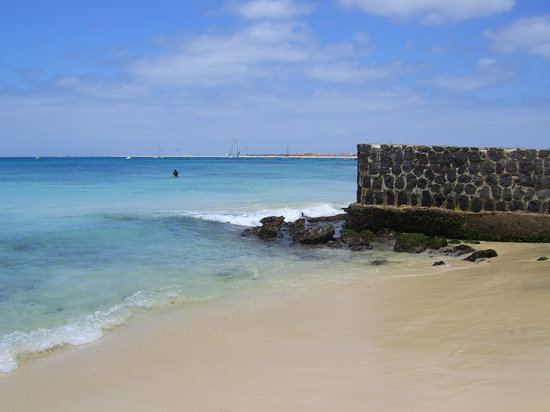Local time Wednesday 1:05 AM | Municipality Sal | |
 | ||
Weather 20°C, Wind NE at 24 km/h, 82% Humidity | ||
Santa Maria (Portuguese for Saint Mary) is a fishing town situated in the southern part of the island municipality of Sal, Cape Verde. Santa Maria is located about 16 km south of the Amílcar Cabral International Airport, and 20 km south of the island capital Espargos. Until 2007, its geography only parts are composed of small barren grasslands surrounding the town and Ponta de Leme Velho, sand dunes with saline marshes dominated the rest of the area. The duneless part of Sal is more than 2 km northwest. The length of the portion of the island around the city for 4 km is no longer than about 3.5 km.
Contents
- Map of Santa Maria Cape Verde
- History
- Points of interests
- Climate
- Panoramics
- Sports
- Notable people
- References
Map of Santa Maria, Cape Verde
The church of Nossa Senhora das Dores is located in town and serves as the seat of the parish. The main square is named Marcelo Leitão. Rua Amílcar Cabral is its main street.
It has two points, Ponta do Sinò in the southwest which is also the island's southernmost point with its own lighthouse and the in the southeast side known as Ponta Preta do Sul. Around its shores, sharks and sea turtles are found. Around a kilometer north of the center is the Santa Maria Saltpans, tracks are in grid plan running 75 degrees towards the east, it is also a protected countryside Further north, made in the late 2000s, is the solar electricity generating station and serves the whole island, since the early 2010s, it is the only source of electricity on the island.
The only foreign consulate in Santa Maria is the French consulate of the island of Sal.
History
Santa Maria was founded in 1835 for the production of sea salt, in its early years, 30,000 tons of salt were shipped from Santa Maria. Most of the product was exported to Brazil, which was halted in 1887 when Brazil imposed a high tax on imported salt to protect its own salt production. The town went into a deep decline, only to recover in 1920 when Portuguese and French investors resumed salt production, one of them J.A. Nascimento and the companies the Cape Verdean Salt Company (Compagnie Salines du Cap-Vert) and the Societé Salins Sal (SSS). During that time, a lighthouse was built in 1892 at Ponta do Sinó. In the 1990s, magnesium was its second producer on the island which lasted to 1907. In 1920, Companhia do Fomento de Cabo Verde which made up a large part of the ownership of the city's port was shortly dissolved. In 1927, salt started to be exported to the Belgian Congo which remained until the nation became independent as Congo-Kinshasa in 1961 and nationalized its salt production. Not long after, Santa Maria was no longer island capital, it was moved to Espargos, at the time a newly created town. In 1967, Belgian Georges Vynckier opened Cape Verde's first hotel named Morabeza. Salt production started to fell and further production lasted until 1984. More recently, tourism has become an important industry on the island which started in the 1990s and accelerated its growth in 2004 and stretches up to about 4 km along the west shore. Many resorts and hotels, including the Riu hotels resorts Riu Garopa and Riu Funana, are situated near Santa Maria, even restaurants opened. The Senegalese forms a small majority, foreigners spend their vacation at the villas during the peak months. In 2013, 40% of the country's available beds were in Santa Maria. Additional hotels and villas recently slowed in 2014 and planned streets and buildings remains in the northern part., a small part the economic crisis in most of southern Europe lowered touristic visits. The town once served ferry routes with Boa Vista.
On April 7, Santa Maria planned to become a seat of its own municipality. due to a massive population growth, Nossa Senhora dos Dores will not exclude Espargos and Palmeira, no date has been set. It would include Santa Maria and Murdeira.
Points of interests
The city's main square is named Marcelo Leitão. Its main streets are Amílcar Cabral, 1 de Maio and 15 de Augusto.
Climate
Santa Maria has a desert like climate. The highest temperature is in August with 28C and its lowest is in January with 22C. Annual rainfall is 286 mm, the wettest is 137 mm in September and the driest are nothing from the months of March to June. Its total average of sunny days is only three. Water temperature ranges from 23 in winter months to 26 in summer and fall months. Humidity ranges from 70% in January, 75% during the summer months and in October to 77% in September.
Panoramics
Panoramics include the southern portion of the island including Monte Leão and the mountains of the east of the island. Boa Vista can rarely be seen.
Sports
Its football (soccer) club includes the island's oldest, SC Santa Maria and GD Palmeira, since the early 2010s, all plays in the honomymous municipal stadium located northwest of the island. Recently new clubs, at a lesser level based in Santa Maria are ASGUI and Florença, who first played their competition in 2015.
Diving, surfing, windsurfing, kitesurfing are popular in its beaches. Santa Maria and Sal Rei have the most popular surfing, windsurfing and kitesurfing dominance in the nation.
